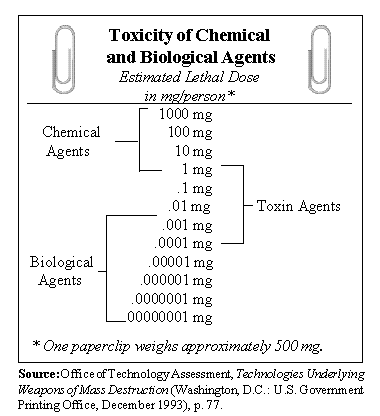Chemical warfare sites:
Technical data on chemical weapons:
Chemical Weapons in Russia: History, Ecology, Politics, by Dr. Lev Aleksandrovich Fedorov, Center of Ecological Policy of Russia: an analysis of the chemical warfare infrastructure in Russia, alleging that money Russia received from the US under the Nunn-Lugar Cooperative Threat Reduction program may have actually been diverted to new chemical warfare manufacturing facilities; also has data on the third generation "Novichok" nerve agents developed during the 1980s - these agents are similar to our agent VX but may be much deadlier and not respond to our present antidotes for nerve gas
A survey of selected papers and statistics on the Russian and Soviet chemical warfare programs by the Federation of American Scientists. Be aware that the facts in this paper are selectively presented from source documents by Dr. Lev Federov and Dr. Vil Mirzayanov, both highly knowledgeable about the Russian CW program; Dr. Mirzayanov was jailed briefly for publicizing previously unknown advanced Russian nerve gas research as well as large-scale contamination of the surroundings of a Russian nerve gas plant, but this information as well as possible duplicity in the Russian CW program is downplayed in the FAS report.
"We Were Preparing for an All-Out Chemical War," another paper by Dr. Fedorov, about secret chemical warfare programs such as "Foliant" which may still be operational despite Russian statements to the contrary and the possibility that chemical weapons may still be ready for use at Russian air and artillery bases
"Chemical Weapons Disarmament in Russia - Problems and Prospects" a report compiled by the Henry L. Stimson Center, including reports on US assistance under Nunn-Lugar, comparative surety and security of the Russian CW stockpile, and a paper by Dr. Amy Smithson on the problematic future prospects of Russian/US cooperation in CW destruction
Emergency.com's
Web page on nerve gases and other poison gases apt to be used by terrorists
NOR Environmental International, North Bay, Ontario, Canada maintains an excellent page of links and information on nuclear, chemical, biological and radiological weapons as part of their corporate Web site - they sell major, high-grade field biological and chemical facilities that can be transported and set up anywhere
U.S. Army Deputy for Technical Services' Publications Web page - detailed data on several chemical warfare agents, including:
H and HD - "sulfur mustard gases"
GA - Tabun, nerve agent
GB - Sarin, nerve agent - used by Japanese terrorist group Aum Shinrikyo in an attack on the Tokyo subway, also found in the Iraqi arsenal and used by "insurgent" terrorists in the past few years, also stockpiled by the U.S. Army, being destroyed by the U.S. Army according to the provisions of the Chemical Weapons Convention
GD - Soman, Soviet nerve agent
VX - a lethal, long lasting nerve agent prominent in the U.S. Army chemical arsenal, being destroyed by the U.S. Army according to the provisions of the Chemical Weapons Convention
and
L - Lewisite, a vesicant (blistering agent), lung irritant and systemic poison
As terrorists and other criminals increase the sophistication of their use of chemicals, we can expect them to take advantage of commercially-available chemicals as weapons. Because of this, I have added the following links for the convenience of law enforcers and other first responders, as well as interested citizens:
US DOT Hazardous Materials Transportation Placards on EnvironmentalChemistry.com - Hazardous materials placards (DOT placards) are required when shipping hazardous materials in the United States, Canada and Mexico. These pages provide pictures and US DOT definitions for each hazmat placard.
2004 ERG (Emergency Response Guidebook) on EnvironmentalChemistry.com - This is an online version of the 2004 ERG (Emergency Response Guidebook) which is produced by the USDOT for first responders during the initial phase of a Dangerous goods/Hazardous Materials incident.
EnvironmentalChemistry.com's Chemical Database - not a complete database of all chemical compounds or even all chemicals apt to be encountered on the roads, railways or open seas, but ought to be helpful in interpreting the information obtained with the aid of the two references above.
The references above can be used to identify (on a strictly informal and unofficial basis) potential toxic chemicals by the four-digit numbers ("UN numbers") and symbols on the placards mounted on the tanks, railcars or vehicles containing them.
 |
A handy table which shows how much of the various lethal chemical and biological weapons it takes to kill the average person.
Study the table and you'll see how much more deadly biological and toxin weapons are than chemical poisons used in industry and older military stockpiles.
In the past 250 years there has been a gradual and ominous movement from chemical weapons such as "Greek fire," white phosphorus, chlorine and various smokes to the much deadlier and more efficient (per ounce or pound of agent) biotoxins and weaponized disease agents (such as the anthrax released in the U.S. Postal System in Connecticut, Florida and Washington D.C. shortly after the attack on New York on September 11th, 2001).
Because biotoxins and weaponized diseases (biological weapons) are thousands of times cheaper than nuclear weapons, some experts in the field call them "the poor man's atomic bomb." The potential of bioweapons to kill thousands to millions of people in a short time frame has not been realized yet, thankfully - but the technology is out there and much more available to the world's terrorists, despots and murderous fanatics
